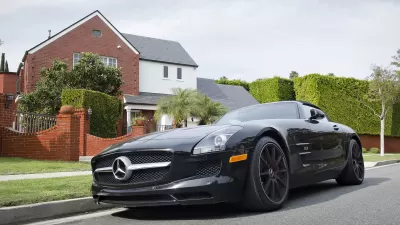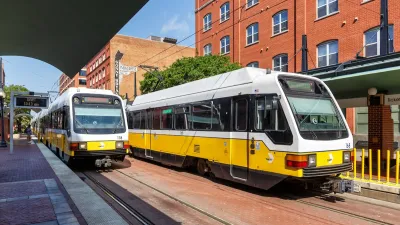Successful driverless cars might lead to "mini mass transit," a distinct mode from public transit and the private automobile. The consequences for land use could reshape suburbia.

David Edmondson speculates on the effects of widespread driverless cars. He envisions a system of personal rapid transit by way of app-driven car sharing. "Open up an app on a phone, order a car, and a vehicle (possibly with others in it going to roughly where you're going) will drive by, pick you up, and drop you off near your destination. Along the way it'll pick up other people going in roughly the same direction as you, bolstering capacity of the personal car to a grand total of five. Five trips, one car. As one Twitter follower called it, it becomes mini-mass transit, but at the beck and call of an app and as flexible as it needs to be."
Significant changes to suburban transportation planning would follow. "Unlike streetcars, the whole street is a possible stop. Rather than a series of one-dimensional stops surrounded by a station area, there is a two-dimensional transportation corridor surrounded by a transportation area."
The article considers potential effects on land use, road design, and suburban density. In time, driverless car transit might shift the definition of "suburban." Edmondson writes, "With no parking lots, no wide roads, a street grid, and shops and homes clustered up against the sidewalk, [suburbia] sounds more like a town center. That's because this transportation cloud functions much more like the streetcars of the old days than personal cars of today."
FULL STORY: What do driverless cars mean for suburban planning?

Alabama: Trump Terminates Settlements for Black Communities Harmed By Raw Sewage
Trump deemed the landmark civil rights agreement “illegal DEI and environmental justice policy.”

Study: Maui’s Plan to Convert Vacation Rentals to Long-Term Housing Could Cause Nearly $1 Billion Economic Loss
The plan would reduce visitor accommodation by 25% resulting in 1,900 jobs lost.

Why Should We Subsidize Public Transportation?
Many public transit agencies face financial stress due to rising costs, declining fare revenue, and declining subsidies. Transit advocates must provide a strong business case for increasing public transit funding.

Paris Bike Boom Leads to Steep Drop in Air Pollution
The French city’s air quality has improved dramatically in the past 20 years, coinciding with a growth in cycling.

Why Housing Costs More to Build in California Than in Texas
Hard costs like labor and materials combined with ‘soft’ costs such as permitting make building in the San Francisco Bay Area almost three times as costly as in Texas cities.

San Diego County Sees a Rise in Urban Coyotes
San Diego County experiences a rise in urban coyotes, as sightings become prevalent throughout its urban neighbourhoods and surrounding areas.
Urban Design for Planners 1: Software Tools
This six-course series explores essential urban design concepts using open source software and equips planners with the tools they need to participate fully in the urban design process.
Planning for Universal Design
Learn the tools for implementing Universal Design in planning regulations.
Smith Gee Studio
Alamo Area Metropolitan Planning Organization
City of Santa Clarita
Institute for Housing and Urban Development Studies (IHS)
City of Grandview
Harvard GSD Executive Education
Toledo-Lucas County Plan Commissions
Salt Lake City
NYU Wagner Graduate School of Public Service




























